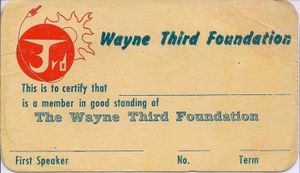Wayne Third Foundation
The Wayne Third Foundation (aka Wayne 3rd Foundation, Wayne Third or W3F) was a fan club that began as a student group at Wayne State University in Detroit in 1969, after Alan Smith put a notice in the campus newspaper. After its members graduated, it continued as an informal social club through at least 1982. The name came from Isaac Asimov's Foundation Trilogy.
The W3F published a fanzine called Seldon's Plan, and put on a few one-day conventions called, appropriately enough, Wondaycon. Members of the club were most of the committee for AutoClave, as well, and founded MiSHAP, which was collated at meetings.
Members have included Terry Austin, Todd Bake, Laura Basta, Margaret Basta, Randy Bathurst, John Benson, Brian Earl Brown, Roberta Brown, Cy Chauvin, Ed Collins, Rich Cook, Howard DeVore, Denice Hudspeth, Michael Kucharski, Mark and Evelyn Leeper, Rick Lieder, Carol Lynn, Gary Mattingly, Gene Mierzejewski, Craig Newmark, Guy Snyder, Jerry Steele, Gregg Trend, Rich Tucholka, and Woody Woo.
Founding members included Smith, Stephen Cook, Paula Blumm, Adwyn Lim, and Alex Vitek.
Suburban Femmefen[edit]
A 1970s subset of the club were the Suburban Femmefen and Mascot, a mostly high-school aged granfalloon who carpooled to meetings together from Oak Park and Royal Oak and hung out at other times. They were: Terry Nutter (the sole adult), Diane Drutowski, Marge Parmenter, Patty Peters, Anne Shoup, Leah Zeldes and Larry Downes (the mascot).
Outside of club meetings, their activities consisted mainly of cruising Woodward Avenue and drinking coffee all night at Elias Brothers Big Boy. They also roomed together at conventions.
W3F Continues[edit]
Many W3F members still live in the Detroit area and get together for periodic parties. Vitek ran running annual reunions for a few years beginning in August 2013. They also maintain a Facebook group.
| Club | 1969—1980s |
| This is a club page. Please extend it by adding information about when and where the club met, when and by whom it was founded, how long it was active, notable accomplishments, well-known members, clubzines, any conventions it ran, external links to the club's website, other club pages, etc.
When there's a floreat (Fl.), this indicates the time or times for which we have found evidence that the club existed. This is probably not going to represent the club's full lifetime, so please update it if you can! |
